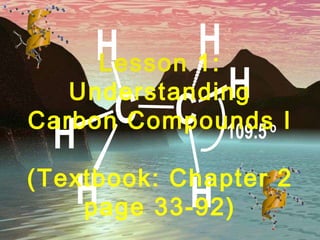
Introduction To Carbon Compound
- 1. Lesson 1: Understanding Carbon Compounds I (Textbook: Chapter 2 page 33-92)
- 2. Today’s Lecture 10.1 Learning Objectives 10.2 Unique of Carbon 10.3 Isomer 10.4 Functional Group 10.5 Saturated vs Unsaturated 10.6 IUPAC Naming Topics Covered
- 3. “ Organic chemistry is enough to drive one mad. It gives the impression of a primeval tropical forest of the most remarkable things, a monstrous and boundless thicket with no way of escape, into which one may well dread to enter” Frederich W ö hler (1835)
- 4. Learning Objectives: 1) Identify the multiple bonding character of carbon atoms 2) Identify carbon as the "backbone" of organic chemistry 3) Define hydrocarbon, alkane, alkene, alkyne, cyclic, and aromatic as they relate to organic compounds 4) Classify a hydrocarbon as either saturated or unsaturated compare the geometry of single, double, and triple bonds between two carbon atoms
- 7. Organic vs Inorganic: Differences Organic Inorganic Bonding Covalent Ionic Physical State (room temp) Gas/liquid common Solids common Melting points Tend to be low Tend to be very high Soluble In water Tend to be insoluble Much higher percent soluble Conductivity Nonconductors Conduct in solution and molten
- 16. Functional Group Functional group Class of organic compound Examples C-C (single bond) Alkane CH 4 methane, C 2 H 6 ethane C=C (double bond) Alkene CH 2 =CH 2 ethene C=C (triple bond) Alkyne CH 2 ethyne (benzene ring) Arene C 6 H 5 CH 3 methylbenzene - OH Alcohol and Phenol CH 3 OH methanol -O- Ether CH3-O-CH3 -halogen, -F, -Cl, -Br Haloalkane CH 3 CH 2 Cl chloroethane
- 17. Functional Group Functional group Class of organic compound Examples Aldehyde ethanal Ketone propanone -COOH Carboxylic acid CH 3 COOH ethanoic acid -COO- Ester CH 3 COOCH 3 -NH 2 Amine CH 3 NH 2 methylamine -CONH 2 Amide CH 3 CONH 2 ethanamide
- 18. Homologous series: series of compounds with similar chemical properties, each member differs from the previous one by the addition of a –CH2- group. The general characteristics of a homologous series are: 1) same functional group and similar chemical properties. 2) differs from the next in the series by a –CH2- group. 3) may be prepared by similar methods. 4) The physical properties- show a progressive change with increasing relative molecular mass. 5) contain the same elements and can be represented by the same general formula. General Formulae
- 19. General Formulae Homologous series General formula Alkanes C n H 2n+2 Cycloalkanes C n H 2n Alkenes C n H 2n Cycloalkenes C n H 2n-2 Alkynes C n H 2n-2 Haloalkanes C n H 2n+1 X (X= Cl, Br, I) Alcohols C n H 2n+1 OH C n H 2n+2 O
- 20. General Formulae Homologous series General formula Aldehyde C n H 2n O Ketones C n H 2n O Carboxylic acids C n H 2n O 2 C n H 2n+1 COOH Esters C n H 2n O 2 Amine C n H 2n+1 NH 2 Amide C n H 2n+1 CONH 2
- 22. General Formulae Homologous series General formula Alkanes RH Aldehydes RCHO Ketones R’COR’’ Alcohols ROH Carboxylic acids RCOOH Esters R’COOR’’ Amines RNH 2 Amides RCONH 2
- 24. Systematic Naming Example: IUPAC name for BrCH 2 CH 2 COOH is Prefix: bromo Parent: propan Suffix: oic 3–bromopropanoic acid
- 25. Saturated compounds (alkanes) have the maximum number of hydrogen atoms attached to each carbon atom Unsaturated compounds have fewer hydrogen atoms attached to the carbon chain than alkanes Unsaturated compounds contain double or triple bonds Saturated and Unsaturated Compounds
- 29. General Formulae IUPAC Name # Carbon Molecular formula Structural formula /Condensed formula Meth ane 1 CH 4 CH 4 Eth ane 2 C 2 H 6 CH 3 CH 3 Prop ane 3 C 3 H 8 CH 3 CH 2 CH 3 But ane 4 C 4 H 10 CH 3 CH 2 CH 2 CH 3 Pent ane 5 C 5 H 12 CH 3 CH 2 CH 2 CH 2 CH 3 Hex ane 6 C 6 H 14 CH 3 CH 2 CH 2 CH 2 CH 2 CH 3 Hept ane 7 C 7 H 16 CH 3 CH 2 CH 2 CH 2 CH 2 CH 2 CH 3 Oct ane 8 C 8 H 18 CH 3 CH 2 CH 2 CH 2 CH 2 CH 2 CH 2 CH 3 Non ane 9 C 9 H 20 CH 3 CH 2 CH 2 CH 2 CH 2 CH 2 CH 2 CH 2 CH 3 Dec ane 10 C 10 H 22 CH 3 CH 2 CH 2 CH 2 CH 2 CH 2 CH 2 CH 2 CH 2 CH 3
- 33. Synthetic polymers provide a wide variety of items that we use every day.
- 34. the bottom line………. …………… .be enthusiastic!
- 35. Thank you Questions and Comments
